I just got off the phone with my dad. I often use the commute to the office to call home and check-in with my mom and dad. We usually chat about the news or things that we have planned for the day, which is exactly how the conversation went today.
Dad: “What do you have planned for today?”
Bjork: “I’m writing a post about SEO for food blogs.”
Dad: “SEO?”
Bjork: “Yeah, it stands for search engine optimization…”
…commence Bjork oversharing with dad about what SEO is and how it works, why it’s beneficial to bloggers, and how we go about doing it for our two sites, Pinch of Yum and Food Blogger Pro.
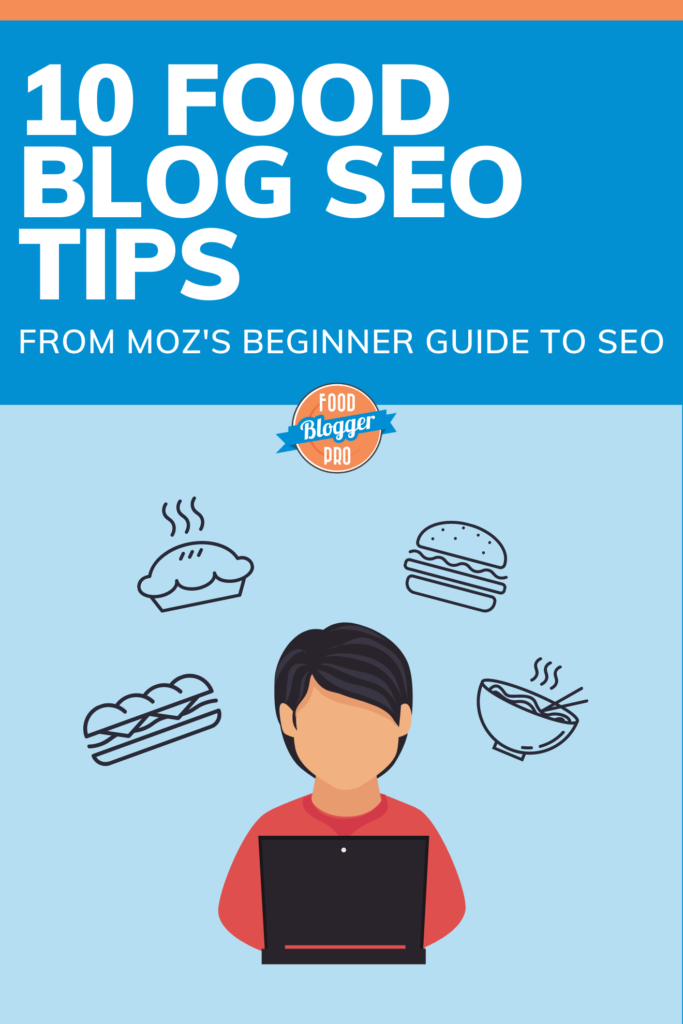
That little SEO soapbox moment made me realize how excited I get when I talk about SEO.
It makes sense, as search engine traffic is one of the most common ways that people discover Pinch of Yum and/or Food Blogger Pro. As the screenshots below show, SEO is an important part of our businesses.
Pinch of Yum traffic from Google in July 2020
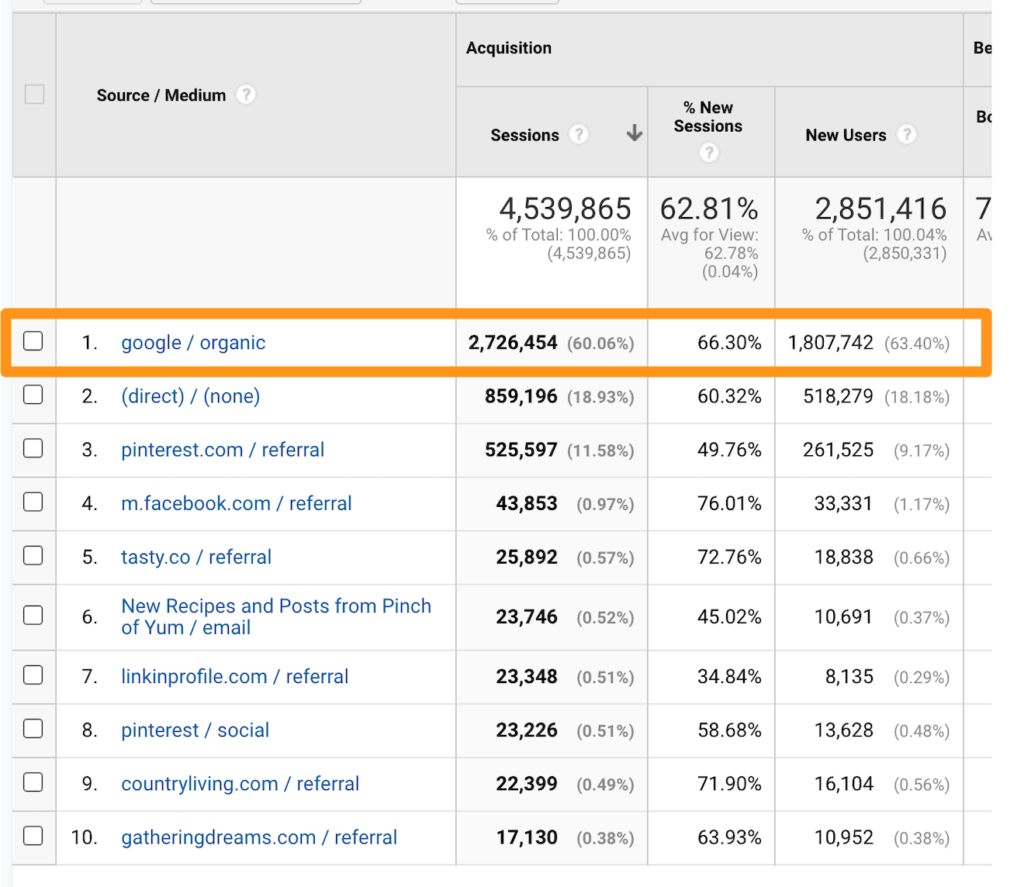
Food Blogger Pro traffic from Google in July 2020
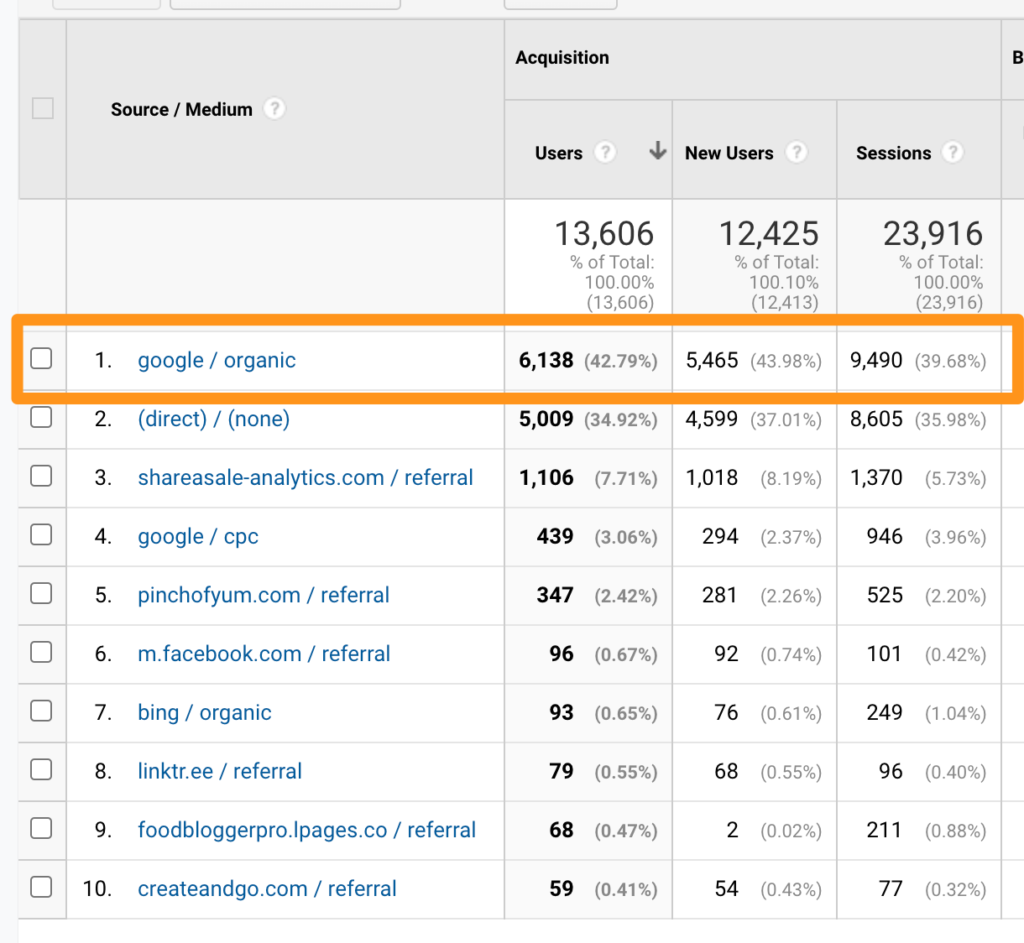
I have a long way to go before I can claim to be an expert on SEO, which is why I still make a point to review content that is created for people that are just getting started with SEO.
One of my favorite resources is Moz’s Beginner’s Guide to SEO. I recently revisited that guide and pulled out 10 things that I learned after reading it. If you have an hour or so I’d recommend that you read through the entire guide.
After reading this post, of course. 🙂
While the content in this post applies to all types of blogs and websites, I’ve crafted the 10 points below so they speak specifically to food bloggers, ’cause those are my people.
1. “A big part of determining where your page will rank for a given query is how well the content on your page matches the query’s intent.”
Said differently, SEO is the art (and science) of creating content that actually meets the needs of the readers.
Said differently again, good SEO is creating content that’s helpful.
The basic ingredients for a helpful food blog recipe post are (1) a really good recipe that is (2) easy to follow and has (3) beautiful photos.
If you’d like to take it a step further, you can add in tips, tricks, or things that make people go, “Hey, that’s cool, I’m going to share this.”
Think about the food-related content that you see online and share. Why is it that you find that content so helpful? How can you reverse-engineer that post and figure out what it is that makes it an awesome piece of content?
It doesn’t really matter how long your post is or how many times you use a specific keyword in your post; at the end of the day, you need to ask yourself if your post is high-quality and if it’s meeting your readers’ needs.
2. Links Establish Authority
There are a ton of different “ranking signals” (aka. factors in Google’s algorithm that determines how content should be ranked in search results). We already talked about a major ranking factor: high-quality content. But another is links.
“Links” can be broken into two different, equally important categories: inbound (also known as backlinks) and internal.
Both kinds of links help you establish your authority, as well as your blog’s place amongst all of the other blogs on the World Wide Web. Not only that, Google’s crawlers can actually discover your content from these links on other sites!
Example time:
Say you have an incredible chocolate chip cookie recipe on your site. If you link to that chocolate chip cookie recipe on another recipe post on your site (say, an oatmeal chocolate chip cookie you developed based on your popular chocolate chip cookie recipe), that would be considered an internal link.
Backlinks, on the other hand, come from external sources. So if another blogger links to “this really awesome chocolate chip cookie recipe [they] made over the weekend,” that mention would “tell” Google that your content was helpful and high-quality.
Another example is if a news outlet like Buzzfeed or HuffPost links to your recipes. They’re already a well-established source of information for the rest of the internet; linking to your recipe tells Google that your content is too.
Now, it’s important to note that not every backlink is helpful. In fact, links from low-quality sources can even hinder your blog’s SEO. But natural backlinks from high-quality sources can help establish your content as important, trustworthy, and relevant.
Here’s a real-world example for ya. Look how many sessions have come from referrals to this Lo Mein recipe on Pinch of Yum:
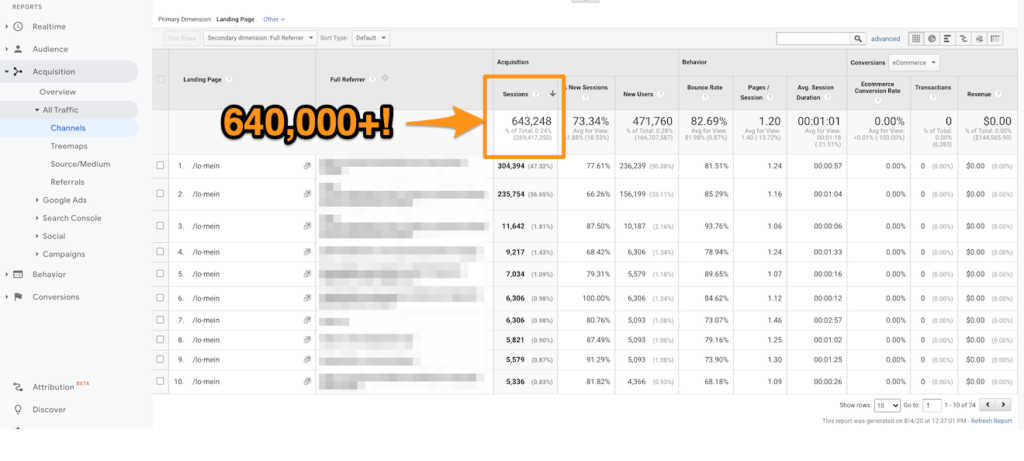
The above Google Analytics screenshot is showing the clicks that are coming over from backlinks to the Lo Mein recipe on Pinch of Yum, which is one benefit of backlinks.
But in my opinion, the biggest benefit from those backlinks is the signal it sends to Google that this specific recipe is authoritative. It showcases the double benefit you get from backlinks: traffic from the clicks PLUS signals sent to Google that the specific post that is being linked to is authoritative.
Want to learn more about the importance of backlinks?3. Create 10x Content
I love Moz’s concept of creating 10x content –– it’s the idea of making your content stand out amongst all of the other search results by making it 10x better than those other results.
Of course, there isn’t a “formula” you can follow to make your content 10x better than other search results. That said, the next time you go and write a recipe post, do a little research, look at which articles are ranking for the keywords you want to rank for, and see what makes those search results so helpful.
4. URL Structure is Used by Readers and Search Engines
How much time do you spend thinking about the URL structure on your site?
I’m guessing not a lot.
But things like the way you name and organize your pages, the URL length, and use of special characters can all impact your site’s SEO.
And it’s pretty easy to see why. If you were searching for a brownie recipe, would you want to click on a URL that looks like this?
https://www.pinchofyum.com/2020/07/recipe-23432-1123Or like this?
https://www.pinchofyum.com/this%20is%20the%20best%20recipe%20everProbably not. Not only do those URLs look a little spammy, they’re tough to read, so you don’t really know if you’re getting a recipe for a brownie if you click on that link.
Something like this is short, concise, and natural. It also contains important keywords like “salted caramel” and “brownies.”
https://pinchofyum.com/salted-caramel-brownies5. 75% of Search is Long-Tail
Thank goodness for the long-tail.
Long-tail keyword traffic is the best concrete example of why the 1% Infinity concept is nearly guaranteed to work when building a blog or a website.
When it comes to search traffic, the chances are much greater that you’ll have thousands of keywords that result in a few clicks versus having a few keywords that result in thousands of clicks.
That’s been true for both Pinch of Yum and Food Blogger Pro, as you can see in these screenshots from Google Search Console:
Total Keywords with clicks for Pinch of Yum (in the last seven days)
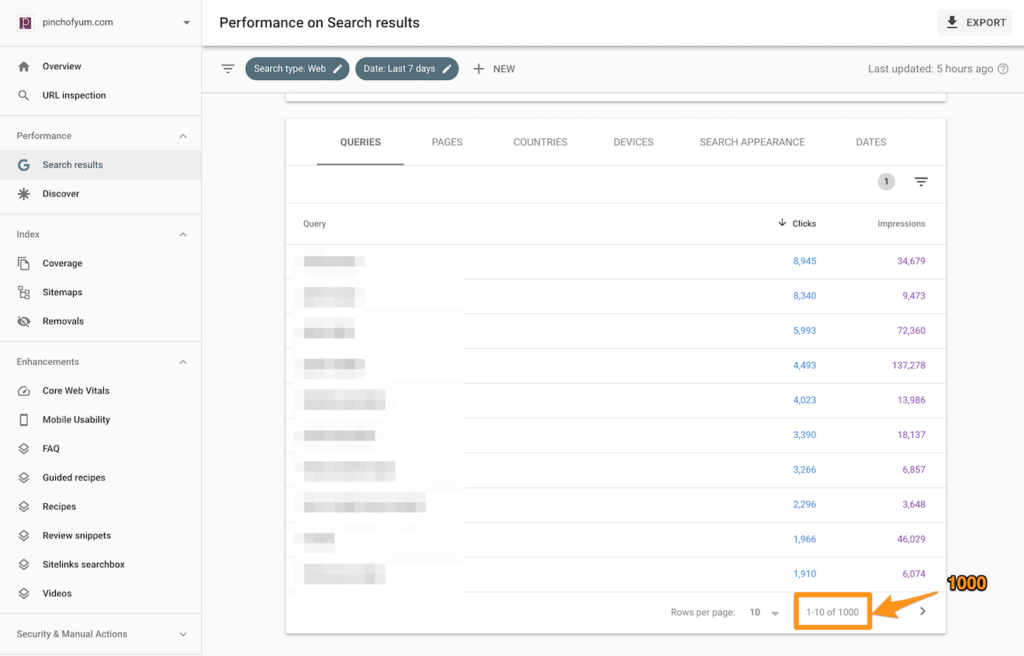
Total Keywords with clicks for Food Blogger Pro (in the last seven days)
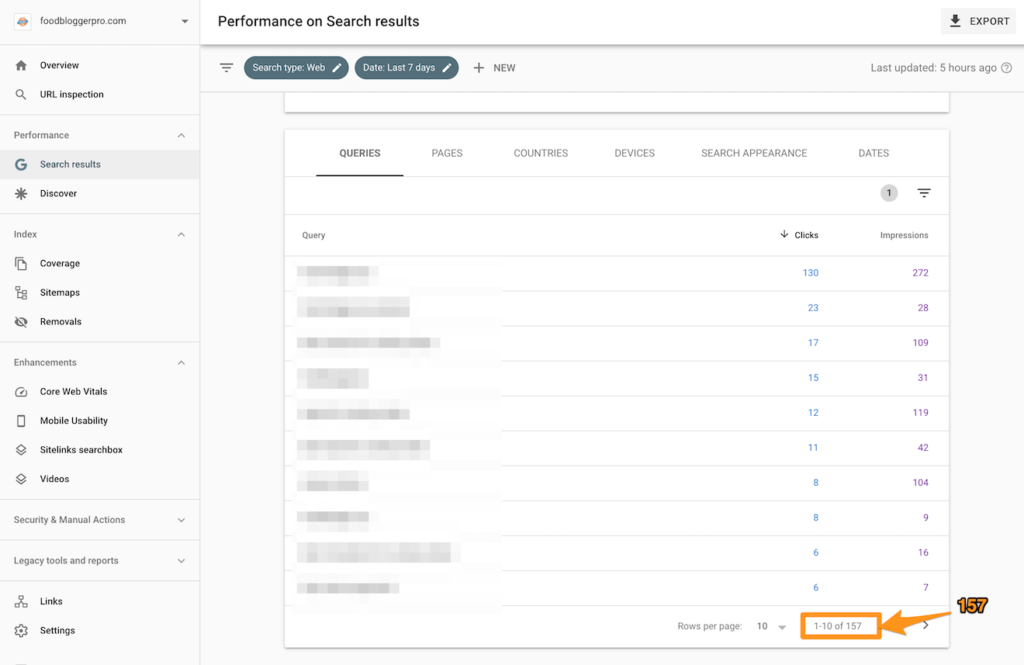
The part I want you to notice with those screenshots is the bottom right corner with the orange box around it. That number represents the number of keywords that have resulted in at least one visitor to the site (in the month of July).
For Food Blogger Pro, it’s 157. For Pinch of Yum, it’s over 1000 (the report only goes to 1000 results).
Over 1000. That’s a lot of different keyword combinations in just seven days!
So why the drastic difference between Food Blogger Pro and Pinch of Yum?
There are numerous reasons, but the most important differences are (1) time and (2) total content. Lindsay has been building Pinch of Yum for over ten years, and it has over 1,000 posts, while Food Blogger Pro has been around for seven years and has just around 150 posts, half of which are low-quality posts (in the eyes of Google), like news about Food Blogger Pro.
Long-tail keyword traffic is one of the reasons why we often preach about the importance of long-term commitment to blogging (with small daily improvements along the way), because, as we mentioned, 75% of search traffic is long-tail, and the best way to build long-tail search traffic is to have lots of awesome content that you’ve been producing for an extended period of time.
Keep in mind that long-tail traffic refers to search traffic, not social traffic. A spike in social traffic oftentimes happens quickly and sporadically, not slowly over time. With Pinch of Yum, we’ve had posts go viral on Pinterest, Facebook, or Instagram. It’s awesome, but short-lived.
Pinch of Yum social sessions over time
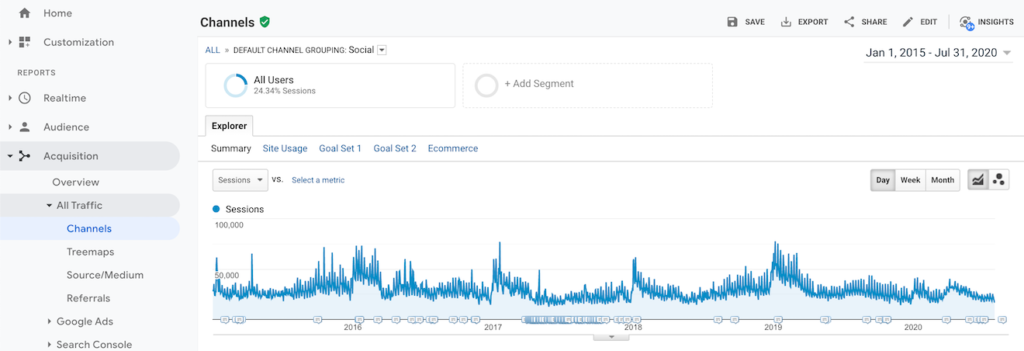
Pinch of Yum search sessions over time
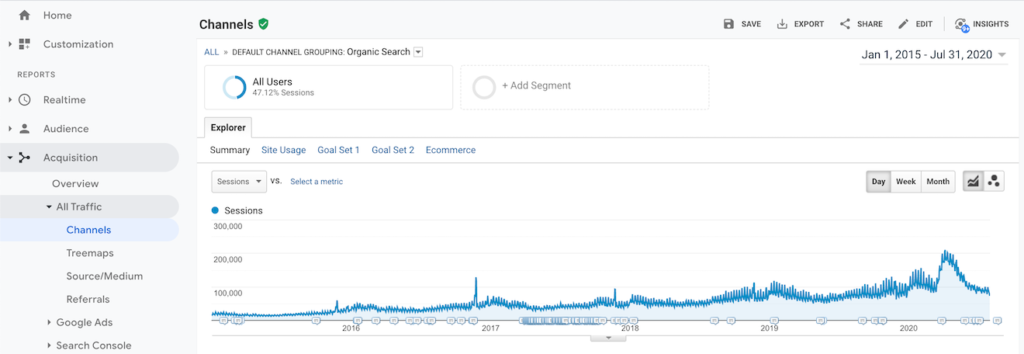
Food Blogger Pro social sessions over time
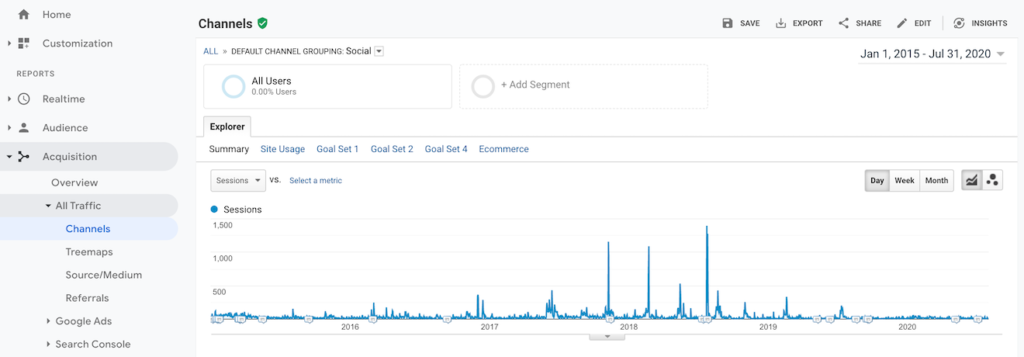
Food Blogger Pro search sessions over time
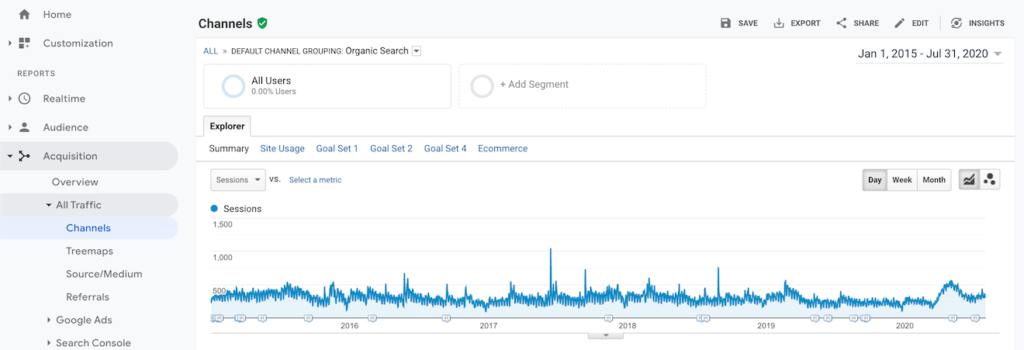
The advantage with the long-tail is that it’s usually a slow and steady climb upwards, as opposed to social traffic which is usually sporadic and unpredictable (albeit powerful).
6. Good site design can positively impact your blog’s SEO
This one always confused me a bit. I had heard people talk about how good design is important for SEO, but I never really understood how Google, a robot, could “understand” what good design is.
The reality is that Google can’t tell what good design is (although it’s getting better at it), but people can, and most people (at least the people I know) really enjoy things that are designed well.
If people really enjoy something then they’re more likely to link to it in a blog post or on social media, and, as we talked about previously, having high quality links pointing back to your blog is one of the most important elements in building the strength of your blog’s SEO.
Formatting like headings, bullet points, short paragraphs, bolds, italics, and text size can all contribute to a better reading experience and affect your post’s ability to show up in featured snippets that appear above organic search results:
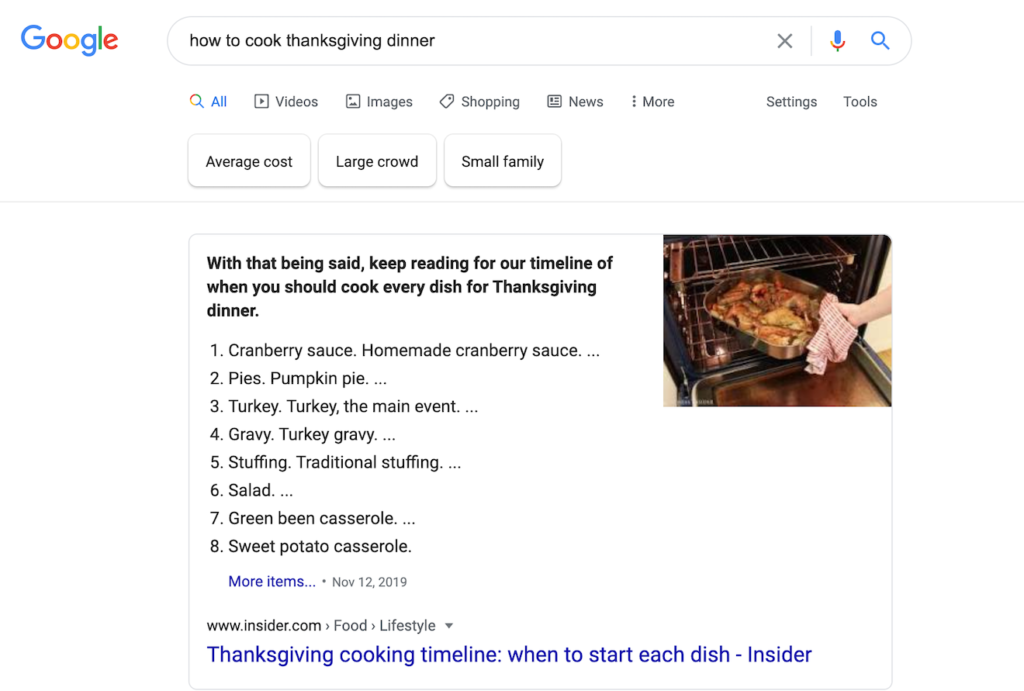
And therein lies the beauty of SEO. It’s both art and science, engineering and psychology. You’re creating content that’s easy to understand for robots, yet highly engaging for humans.
7. “You are what you E-A-T”
The concept of E-A-T is very “on-brand” for food bloggers, don’t you think? 😉
E-A-T stands for expertise, authoritativeness, and trustworthiness, and sites that have high levels of E-A-T are seen as high-quality resources and create a more well-rounded, future-proofed site.
What helps you build your food blog’s expertise, authoritativeness, and trustworthiness? Things like:
- Links back to your site from high-quality, credible sources
- Comprehensive, easy-to-follow, and well-written recipes
- Links to helpful, high-quality resources where your readers can go to learn more
- Proof of your recipe development process and reasons why you chose the ingredients for the final recipe
- Meaningful, high reviews from people who have made your recipes
What does a recipe post with a high level of E-A-T look like? Google’s Search Quality Rater Guidelines links to Tessa’s Ultimate Guide to Chocolate Chip Cookies as a really good example.
If you check it out, you’ll see that it shows she’s done extensive research and experimentation on baking chocolate chip cookies. She shows how different ingredients can affect the outcome of the recipe, offers guidance on tools that will make the cookie-making process easier, and talks about the specific brands of ingredients she likes to use.
E-A-T at its finest!
8. “Google wants you to earn links, not build them.”
We’ve talked about the importance of links a few times in this article, but link-building can go awry if you do it in a spammy way.
It can be tempting to buy links back to your site or participate in a bunch of link exchanges to quickly build backlinks, but Google sees those as low-quality links. Worst-case scenario: Google can penalize you for these types of link-building schemes. 😔
Moz has a ton of advice for earning high-quality backlinks here, but here’s a quick overview:
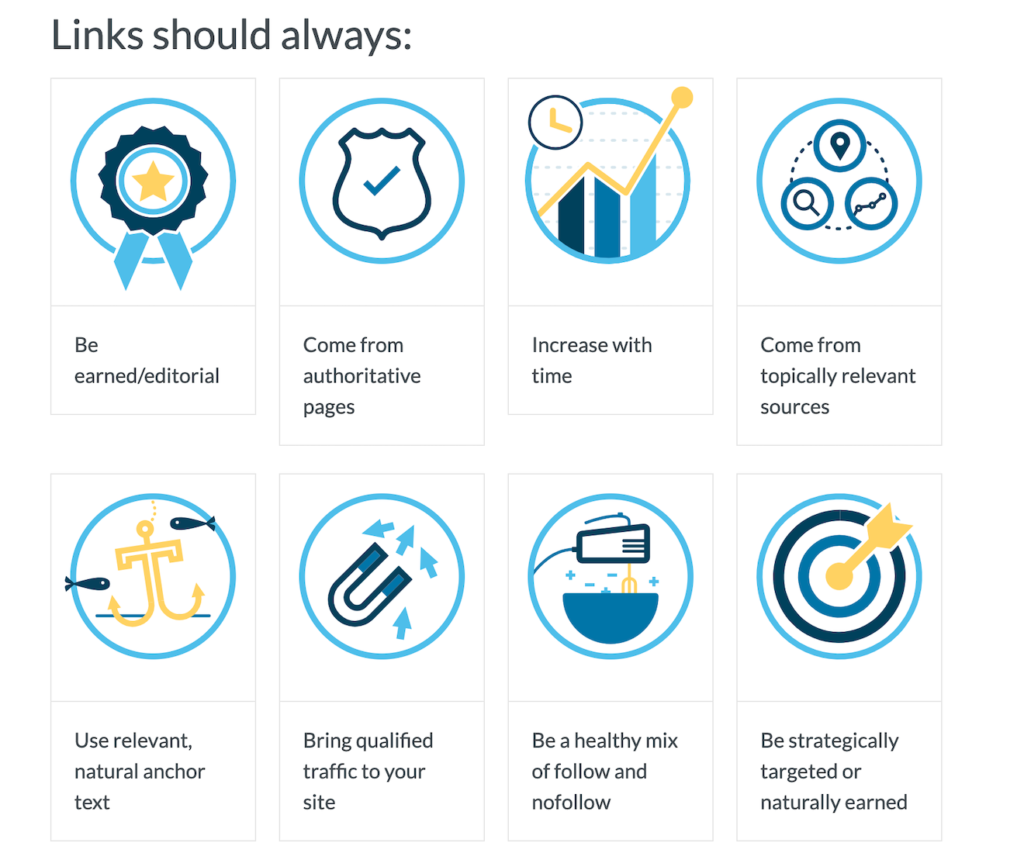
9. “Measuring the impact of your work and ongoing refinement is critical to your SEO success, client retention, and perceived value.”
This concept is incredibly important.
So many people use analytics and traffic numbers as “huh, that’s nice to know” type information. We check our stats, see that the numbers have gone up (🥳) or down (😭), and then go back to our normal routine.
But SEO isn’t a “one and done” kind of thing. Earning links, high amounts of E-A-T, and search rankings takes constant effort that needs to be monitored, measured, and adjusted over time.
10. The Beginner’s Guide to SEO is a great example of good SEO.
Check out the search results for the term “SEO.”
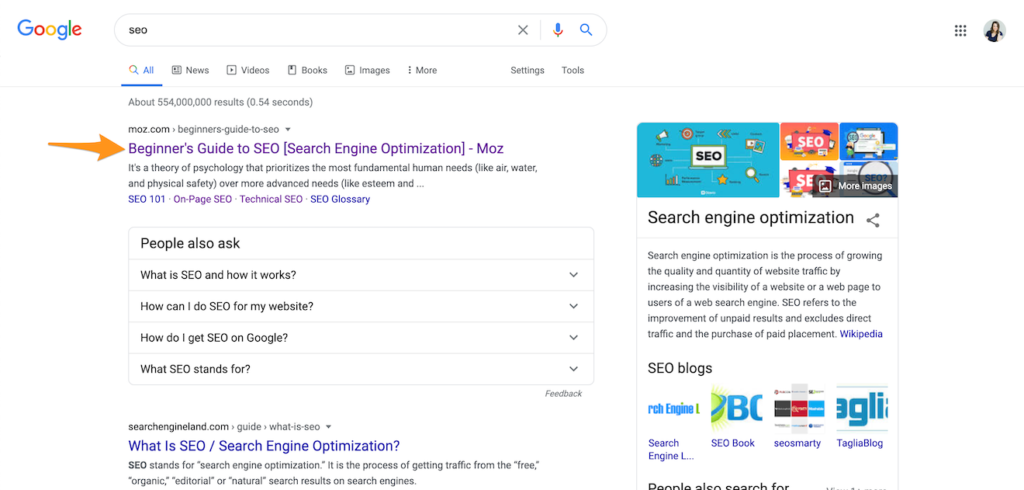
There’s the Beginner’s Guide to SEO from Moz at the #1 spot.
That’s what I call proof of concept!
This is especially true considering the fact that the keyword “SEO” is an incredibly competitive keyword to rank for. Just think about it: the companies that are trying to rank for that keyword are all companies that are experts in the field of ranking high on search engines. That’s some stiff competition.
My point? If you’re wanting to see an example of content that is crafted in a way that helps it rank high in search engines, and learn about SEO in the process, be sure to check out the Beginner’s Guide to SEO.
Conclusion
The bottom line: Good SEO is less about tips, tricks, and SEO tactics and more about creating high-quality, engaging, well-designed, human-first content.
This post was in no way sponsored or connected with Moz. We’re not affiliates and there’s no incentive for us in creating this post. If you have some time I’d recommend that you pour a cup of coffee and sit down and read through the entire guide.
What other SEO tips do you think are important for food bloggers to know? Are there things you learned from this post (or from the Moz guide) that you didn’t know before? What are some questions you have about SEO?
I’d love to hear your thoughts in the comment section below.
This is a great reminder Bjork and awesome tips. Sometimes I struggle with tweaking small settings and it’s important to take a larger view and just remember that creating good content on a well-designed site is a good chunk of the game.
For sure! I’m right there with ya. It’s easy to get caught up in the small things. Great to hang out with you a bit this weekend Nick!
Yea man. Ditto. Great meeting you and Lindsay. Hope you got to use some of those fast passes!
fast pass = Toy Story laser ride on repeat.
I will try to put your advice into practice. I’m stuck with the SEO topic on my blog.
So glad to hear you found the post helpful, Irene! Let us know if you have any questions 🙂
Some great seo advice and talk to your dad more! i miss mine….:)
Hey Robert – It all comes down to family and friends, doesn’t it? Thanks for the reminder.
Thanks. Reminded me to go and reread this again!
Thanks Dustin! It’s a great resource. I’m going to try and make a point to reread it once every 6 months or so.
This for this post Bjork! This really breaks SEO for food bloggers in a simple, comprehensive way! You rock!
No, YOU rock!
Great detailed information, especially for newbies who are forever learning. Thank you!
Always forever learning! 🙂
Yay! Glad you made a nice header image for this. #pinterest
Thanks Abby. 🙂 Better late than never, right?
Thanks for sharing all of this info– I learned a lot and especially am glad to know more about that (not provided) line. Seems odd to me that Google seems to track everything but it doesn’t share the keywords that its own users are typing in? Is that a privacy issue or something? I will click though your link to learn more. Thanks, as always!
I haven’t researched enough to know for sure, but my understanding is that when people are logged in to their account they’re using a secure protocol (https), so Google is careful about what information they “send” back and forth.
As always, a “good read”! Thanks Bjork for the amount of time and care you took to write this post. Pinning to Pinterest and I ditto Abby’s comment on your header image!
Thanks Carole! Really appreciate that.
Great info as always Bjork! I am pinning this.
Thanks Marjorie!
I am lost in a web of links and haven’t started work today! these are all so amazing. thanks to both of you for always making such great content. xo
Thanks Lynsey.
Really great info like usual! I now have ALL THE TABS open and many things to read. Thanks!
Story of my life. SO MANY TABS.
Me too! The kids have gotten to the point where they feel the need to count them. “Mom, you have 23 tabs open!!!” Me: “Yeah, I know. I’m ridiculous.”
It’s just how I operate. 🙂
Thank you so much Bjork! Thanks to you I noticed that my metadescription was gone and was able to write it again 🙂
Awesome! Glad you caught that Joana.
Good to know about #8 – I always wondered about that! Mine is about the same, 90% unprovided so I just try to focus on what IS provided, which is still pretty helpful. Also one of my greatest pet peeves is %20 in a URL.
Same. Curse you %20!
Great article! So glad you took the time to write it up. I have so much to learn about SEO. This breaks it down in little chunks.
Looking forward to getting through the MOZ guide.
Thanks for breaking down a complicated topic in such a fantastic article!
Great post. Everything is explained with example. I really like the concept.
SEO Outsourcing Company
Awesome article brother i opted your each and every idea u can check my website
http://www.iaspaper.in and let me know do i need to change anything else?
Waiting for your replay…………..
Dear Bjork Ostrom, thank you for your excellent article you put title “10 Food Blog SEO tips from Moz’s Beginner’s Guide to SEO”. By the way I want to know more about 70% of search is the long-tail. Is it true? Can you assist me on this topic? Keep the great writing skill up. Thanks again Buddy! You are invite in oDesk Live Chat
I was so confused when I visited this website. I thought this is a place where hungry SEO experts come to check out new recipes 🙂 Great article Bjork! Really thorough!
haha this comment is perfect. Oh, and this article is as well. Great job Bjork!
Great article! There are so many overly complicated articles on this topic, so I’m glad o have found this one 🙂 I’ve been wondering, if you’d have two very similar recipes, that you’d naturaly give the same keywords, what would you do then? Would giving them the same keywords hurt your SEO?
I think UX and UI is more important than SEO, if people like what they see on your website they will keep coming back for more
Hi Bjork, thank you so much for the wonderful and informative post!! I signed up for the blogging tips newsletter but never received the email confirmation to download the ebook. Can you please help me with it? Thank you so much!!
such a great blog.Thanks for sharing this nice information with us.
Thanks for sharing basics with us. I knew some about seo but I was bit confuse for my food recipe website( http://www.recipesfriend.com/ ). Thanks for clearing my mind.
Keep continue!!
great .. ! very useful post for all the beginners , i have so much to learn about ..some of the web development company in India, in their blog they also followed the same tactics like high quality content ,well design and got high traffic and shared it in their blog. very useful for us.thank you so much.
Such great strategic tips for SEO and very glad to read.Hope to see your next blog soon.
Hey Bjork! This is a great article by Moz. I saved and read (over a period of months!) the Moz guide on SEO and found it super helpful. I especially liked the concept of E-A-T too.
And the long-tail keyword it somewhere I’m focusing for 2021 as well. I would look at my “average rank” in GSC but now I’m focusing down on specific pages (posts/recipes) and focusing on ranking higher for the long-tail keywords. I first read about this from Neil Patel but didn’t really apply it until recently (link here for those interested):
https://neilpatel.com/blog/a-step-by-step-guide-to-integrating-long-tail-keywords-within-blog-posts/
Another thing I’m keeping top of mind for 2021 is helping to make my reader “feel at home on my site”. Something I read a while ago and never really thought of it before. Really like the concept: hey, stay a while. You may like what I have here😄
Thanks for a great summary,
April
That article is awesome — thanks for sharing, April!
Also, I LOVE the idea of making your readers “feel at home on your site.” The goal is to definitely keep them scrolling around and want to learn more about you and your brand!
That’s really informative post. I appreciate your skills. Thanks for sharing.
Thanks for reading! We’re so happy you enjoyed the post 🙂
Your advice is very practical. I am stuck with my recipes blog. You helped me know what to do next.
We’re so glad you found the post helpful, Hải!
Hi there! thanks for sharing such an informative article, I will surely apply these tips and share the outcome with you.
Thanks for reading, Priya!
hi Bjork, really appreciate the efforts you have put in! I was very confused about setting up my first food blogging website, thanks again for the guide
We’re so glad you found the post helpful, Stanley! Wishing you the best of luck with your blog. 🙂
Terrific post, thanks Bjork. Will refer to it many times as a reminder. Love being part of FBP!
Yay, Sally — we’re so glad to have you as part of the FBP community! ❤️
Thanks for this guide. I hope it will works